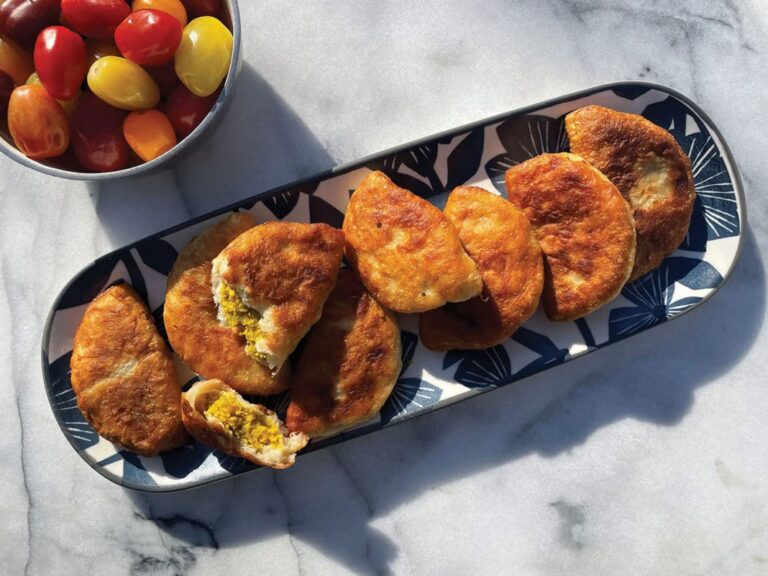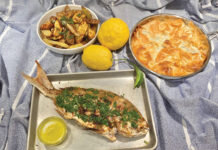A Fruitful Tu B’Shevat Celebration
How lucky are we to have a holiday that is observed by planting trees, eating fruit, and meditating on the spiritual significance of man’s relationship to nature and G-d?

Have you ever driven up the winding road that leads to the city of Tzfat? The deserted landscape of broken rocks and tall green pine and cedar trees gives way to the occasional glimpse of the bright blue Kinneret that grows ever smaller in the distance.
One of the four holy cities of Judaism, Tzfat is located in the scenic hill country of the Northern Galilee. The narrow alleys and white stone buildings of the Old City are suffused with a mystical air. You can almost feel the holiness in the air.
First mentioned at the time of the Jewish revolt against the Romans (66-70 CE), it is then often referred to in Rabbinic literature. In the 16th century Tzfat became the spiritual center of the Kabbalah, home of the mystics Isaac ben Solomon Luria (Ha’Ari) and Rav Yosef Karo. The Ari created the Tu B’Shevat seder that has become a popular tradition for “Chag Ha’Ilanot” (Festival of the Trees). Celebrated on the 15th day of the Hebrew month of Shevat, this holiday is considered one of the four “New Years” in the Jewish calendar and is traditionally viewed as the birthday of the trees (Mishna RH 1:1).
The Seder entails eating a meal centered on the seven species special to the Land of Israel wheat, barley, grapes, figs, pomegranates, olives and dates. The seder is intended as a mystical correction of Adam’s sin in eating from the Tree of Knowledge. By eating of the seven species, one essentially becomes a partner-in-creation with G-d.
How lucky are we to have a holiday that is observed by planting trees, eating fruit, and meditating on the spiritual significance of man’s relationship to nature and G-d?
—Sharon
Recently, Sharon and I were planning this Tu B’Shevat article. We were reminiscing about the foods that were always served at meals when we were growing up and I said “Whatever happened to a good fruit salad?”
Dessert for our families always involved fruit salad. For weeknight meals, it might be just three or four fruits, like apples and oranges, cut up together. For Shabbat dinners and lunches, high holidays and birthday parties, the fruit salad was totally festive with fresh berries, walnuts and liqueur.
Then, fruit salad disappeared from menus.
I decided that we would have a blast from the past and I made a fruit salad exactly the way my mother always did. The contrast of all the colors and textures was just beautiful to see and even more delicious to eat.
This past Friday night I had a big crowd because my cousin Alia’s daughter Bianca is visiting us from the island of New Caledonia which is part of French Polynesia. I decided that we would have a blast from the past and I made a fruit salad exactly the way my mother always did. The contrast of all the colors and textures was just beautiful to see and even more delicious to eat. I added a little more liqueur than the recipe called for, because in this case I really do believe more is better. Everyone enjoyed the refreshingly chilled, sweet fruit salad.
I asked everyone at the table why they thought fruit salad had waned in popularity and my niece Annabella said “Fruit platters!” (Funnily enough, Sharon’s daughter Alexandra had the same response when we shot this photo for the Journal.) This got me thinking about the ’90s when we all started watching the Food Network. One of my favorite television shows has always been The Barefoot Contessa. One of the very first episodes that I watched, the one that truly made me fall in love with her, was the one where she shows how to make a simple, elegant fruit platter. I was a newlywed, starting to entertain my friends and family, and obviously wanted to impress my guests. I always think of her whenever I assemble a fruit platter. You start with a large platter and place beautiful leaves from the garden, then arrange the fruit in separate sections, making sure not to mix them.
Fruit platters definitely have their place. But there’s something nostalgic when everyone has their own little glass bowl with their fruit salad, where every spoonful has a unique combination of fruit and everything tastes so good, especially the juice at the bottom of the cup. Personally, I miss those days. Sign us up for more fruit salad.
—Rachel
This brilliant fruitcake became a family tradition one Passover. Cleverly, my mother combined a bunch of dried fruits and nuts in her food processor and added the mixture to her usual cake ingredients.
Soon after, my niece Ines was restricted to a gluten-free diet. And for years, my father had been told to avoid white sugar because of his diabetes. Since my mother used no white sugar or maple syrup, this cake was a perfect dessert. It became a weekly treat and the entire family would indulge with a nice cup of Maman ‘s mint tea.
The chopped nuts and dates add incredible crunch and texture. It’s heavenly.
— Rachel
Maman’s Dried Fruit and Nut Cake
1 ½ cups toasted walnuts or slivered
almonds or hazelnuts
1 cup pitted dates
½ cup dried figs
1 1/2 cups dried fruit (any combination of
apricots, raisins, cherries or blueberries)
2 cups gluten-free flour (King Arthur is
best) or all-purpose flour
2 teaspoons baking powder
Pinch of salt
2 teaspoons cinnamon
¾ cup water
¼ cup orange juice
2 large eggs
1 cup maple syrup
1/3 cup avocado oil
Preheat the oven to 350°F.
If using a Bundt pan, grease the cake pan with spray. If using a square brownie pan, line with parchment paper and spray.
Roughly chop the nuts and dried fruits and set aside.
In a large bowl, whisk the flour, baking powder, salt, cinnamon, then set aside.
In a bowl, combine the water, orange juice, eggs, maple syrup and oil. Pour into the flour mixture and combine using a rubber spatula.
Gently fold in the nuts and fruits. Do not overmix as this causes the cake to become dense.
Bake for 50 to 60 minutes
Cool completely before serving.
This cake freezes well when wrapped tightly with a layer of plastic wrap and a layer of foil.
Optional glaze:
2 cups confectioner’s sugar
2 tablespoons orange blossom water
A few drops of your favorite food coloring, optional
Mix together and drizzle over the cake.
This fruitcake is a wonderful way to incorporate the dried fruit and nuts that are often eaten at Tu B’Shevat.
Favorite Flashback Fruit Salad to Feed a Crowd
2 oranges, peeled and cut into 1/2 inch cubes
2 golden delicious apples, peeled, cored
and cut into 1/2 inch cubes
2 pears, peeled, cored and cut into ½ inch cubes
15 ounces green grapes, cut in half
12 ounces strawberries
6 ounces blueberries
6 ounces blackberries
1 15 ounce can peaches, cut into pieces,
with juice reserved
1 15 ounce can cubed pineapple, with juice
reserved
1 cup pomegranate arils
1 cup orange juice
½ cup Cointreau or Grand Marnier, optional
In a large bowl, combine all the fruits, orange juice and liqueur.
Chill in the refrigerator for 2 to 4 hours.
Be creative by adding any fruits in season, such as melons and stone fruits in the summer. The possibilities are endless—kiwi, passion fruit, mango and even banana.
Rachel Sheff and Sharon Gomperts have been friends since high school. They love cooking and sharing recipes. They have collaborated on Sephardic Educational Center projects and community cooking classes. Follow them on Instagram @sephardicspicegirls and on Facebook at Sephardic Spice SEC Food.







